2023 Lexus IS Review and Test Drive
This is the closest thing to a Japanese BMW 3 Series you can buy, and it's still available with a V8 engine.
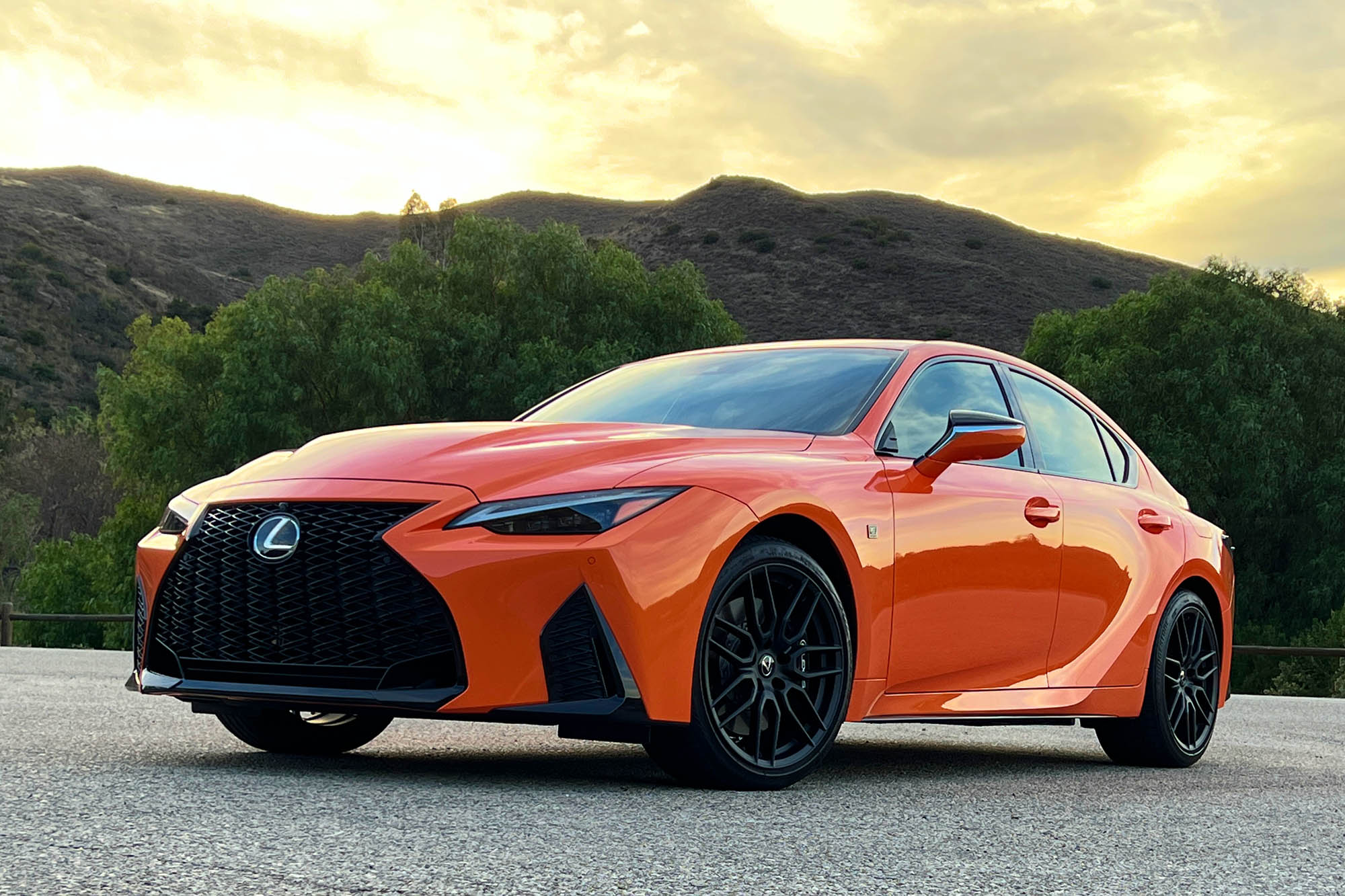 Christian Wardlaw
Christian Wardlaw
Accelerating to 60 mph in 4.4 seconds is no longer a big deal. After all, a Hyundai Ioniq 6 family sedan silently whooshes to that velocity in about 5 seconds. But no electric car offers the urgently visceral and seductively symphonic sound of a V8 engine revving underneath the bulging hood of the 2023 Lexus IS 500.
The IS 500 tops the 2023 Lexus IS lineup, giving the small sports sedan the performance it needs to compete with similar rivals. There are more of them than you might guess. Asian alternatives include the Acura TLX Type S and Infiniti Q50 Red Sport 400, while the Audi S4, BMW M340i, and Mercedes-AMG C 43 are the European competitors. Cadillac still builds a car like this, too: the CT4-V Blackwing. None has a V8.
Does that matter? Not really. Increasingly, V8 engines are anachronistic throwbacks to an era when driving enthusiasts thought there was no replacement for displacement. As it turns out, there is. Nevertheless, nothing else sounds like a V8, and in the Lexus tradition, the IS goes about its business in a quieter, softer way than its competitors.
Lexus stuffed a V8 into the IS once before. The original IS F had a thundering 5.0-liter good for 416 horsepower and a similar time to 60 mph. Surprisingly, today's IS 500 F Sport Performance doesn't cost much more than the IS F of 15 years ago, despite using a similar recipe in its bid to run with the big dogs.
The V8-powered Lexus IS 500 arrived in 2022, and for the 2023 model year, it is available with a new Special Appearance Package with Molten Pearl paint and matte-black BBS forged aluminum wheels. Lexus will build just 150 examples of it, making it a rarity. In 2024, its replacement will wear Blue Vector paint, and Lexus will produce it in the same limited quantities.
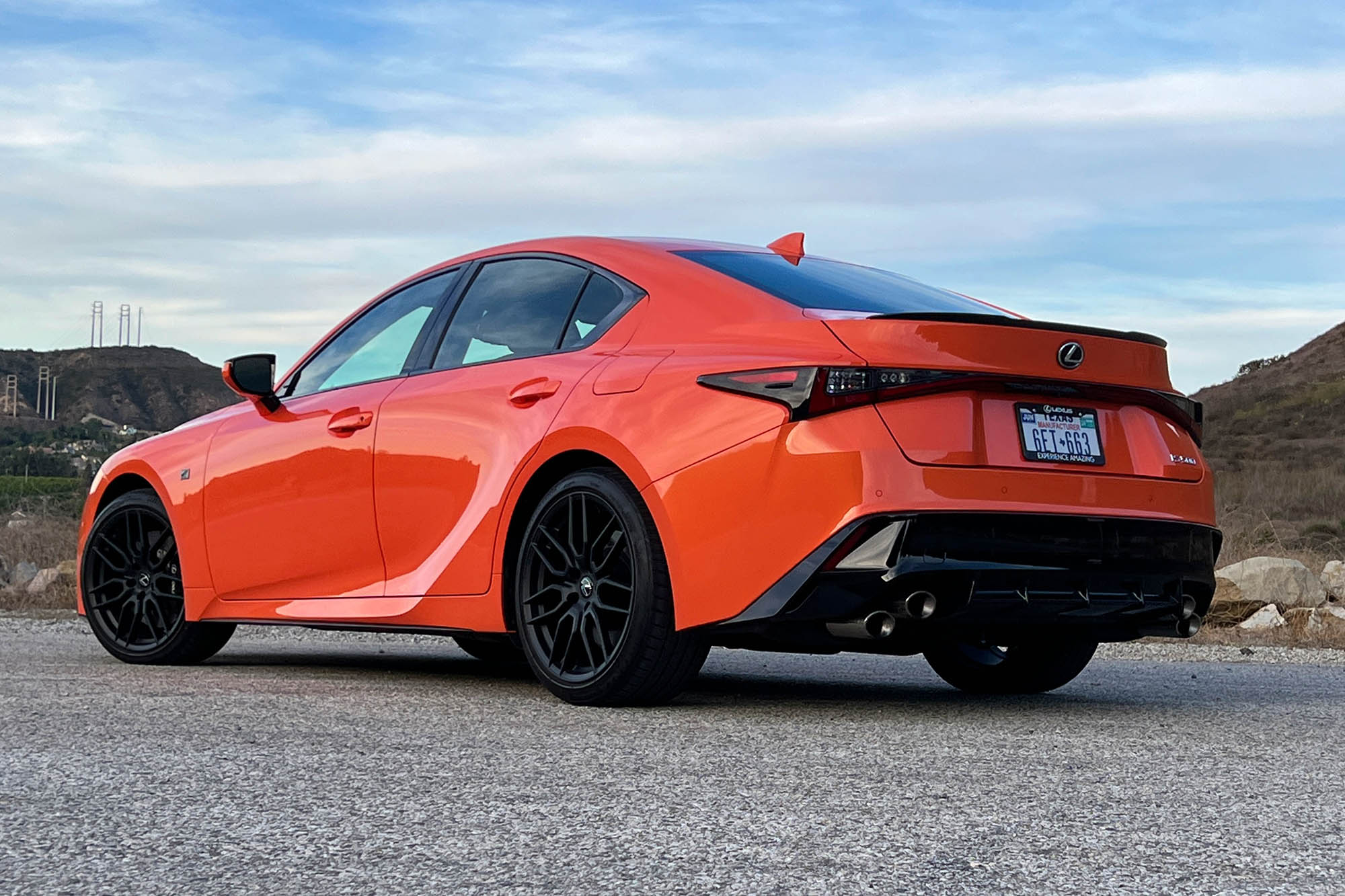 Christian Wardlaw
Christian Wardlaw
The 2023 Lexus IS Price Range Reflects Value, Especially the IS 500
The 2023 Lexus IS comes in IS 300, IS 350, and IS 500 model series. Base prices range from the low $40,000s to the mid-$60,000s, including the destination charge to ship the car from the Tahara, Aichi, Japan factory that builds it to your local dealership.
I test-drove the IS 500 F Sport Premium in Southern California for this IS review. It came with this year's Special Appearance Package and an all-weather trunk tray, bringing the manufacturer's suggested retail price to $67,060, including the $1,150 destination charge. Lexus provided the vehicle for this IS 500 review.
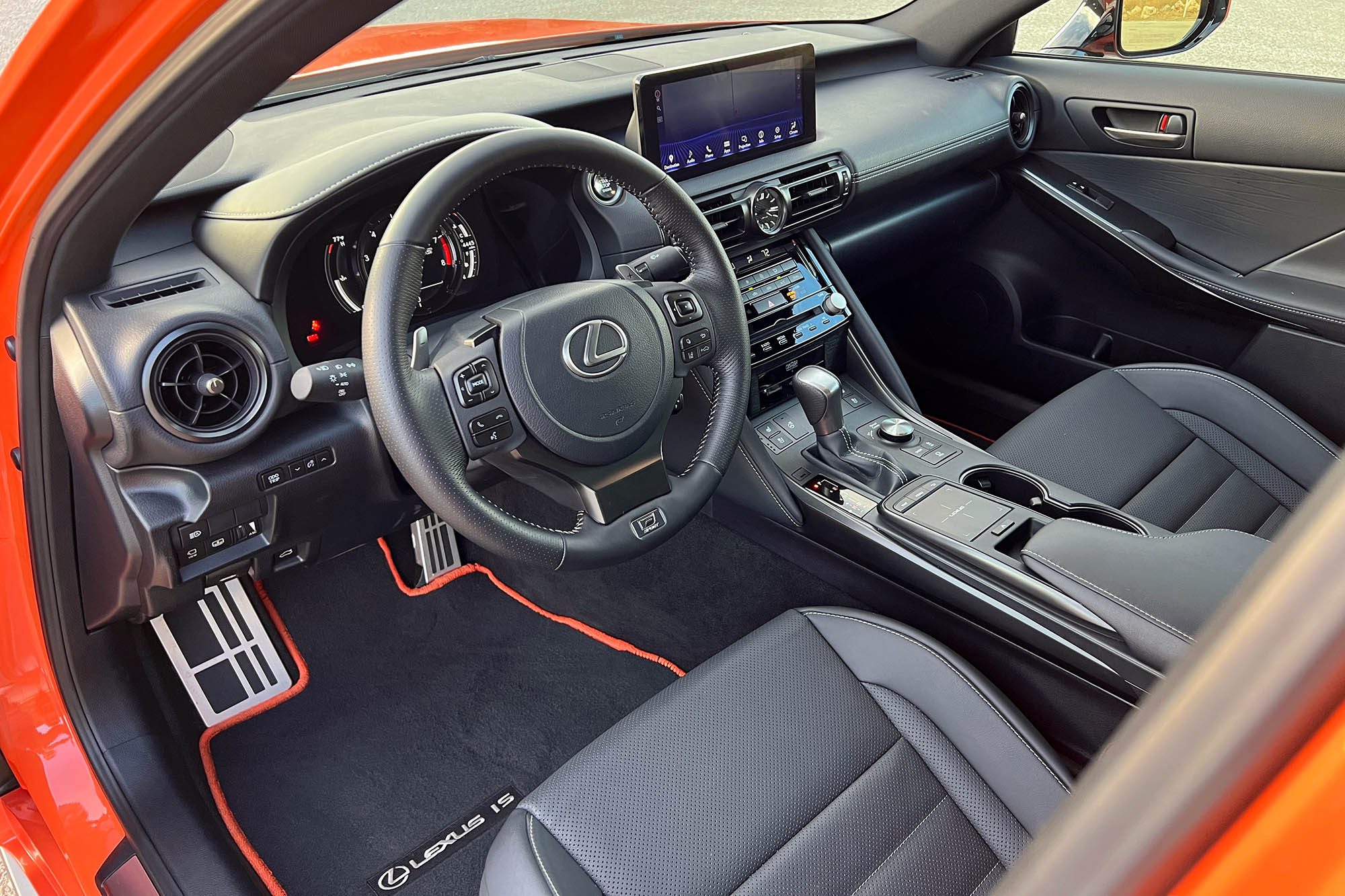 Christian Wardlaw
Christian Wardlaw
Expressive Styling, Retro Interior
I don't like flashy cars that attract attention, and I've never been a fan of the modern Lexus grille. But, I do find the IS sedan's distinctive styling appealing, depending on the model, color, and wheel design.
To set the IS 500 apart, Lexus adds F Sport exterior design cues, exclusive 19-inch wheels, a raised hood to clear the V8 beneath, and quad-stacked exhaust outlets through which it bellows. With Premium trim, the car has upgraded triple-beam LED headlights. I wouldn't get one in Molten Pearl (or Blue Vector), but I think Cloudburst Gray with a white interior would look terrific.
Based on the test car's relentlessly black cabin, it needs the stark contrast between the white or Circuit Red NuLuxe upholstery for some upscale personality. The IS 500's standard aluminum pedals and satin trim alone don't break up the monotony.
As has always been the case with the IS, Lexus assembles the interior carefully, using quality materials with only a few exceptions. For example, the plastic glove compartment door looks like it came out of a Toyota.
Lexus also sprinkles knobs and buttons throughout, which is excellent if you like knobs and buttons. During the IS model's last refresh, it gained a touchscreen display, eliminating the need for the reviled Remote Touch Interface pad on the center console. Unfortunately, it remains and takes up space that would be better used for storage.
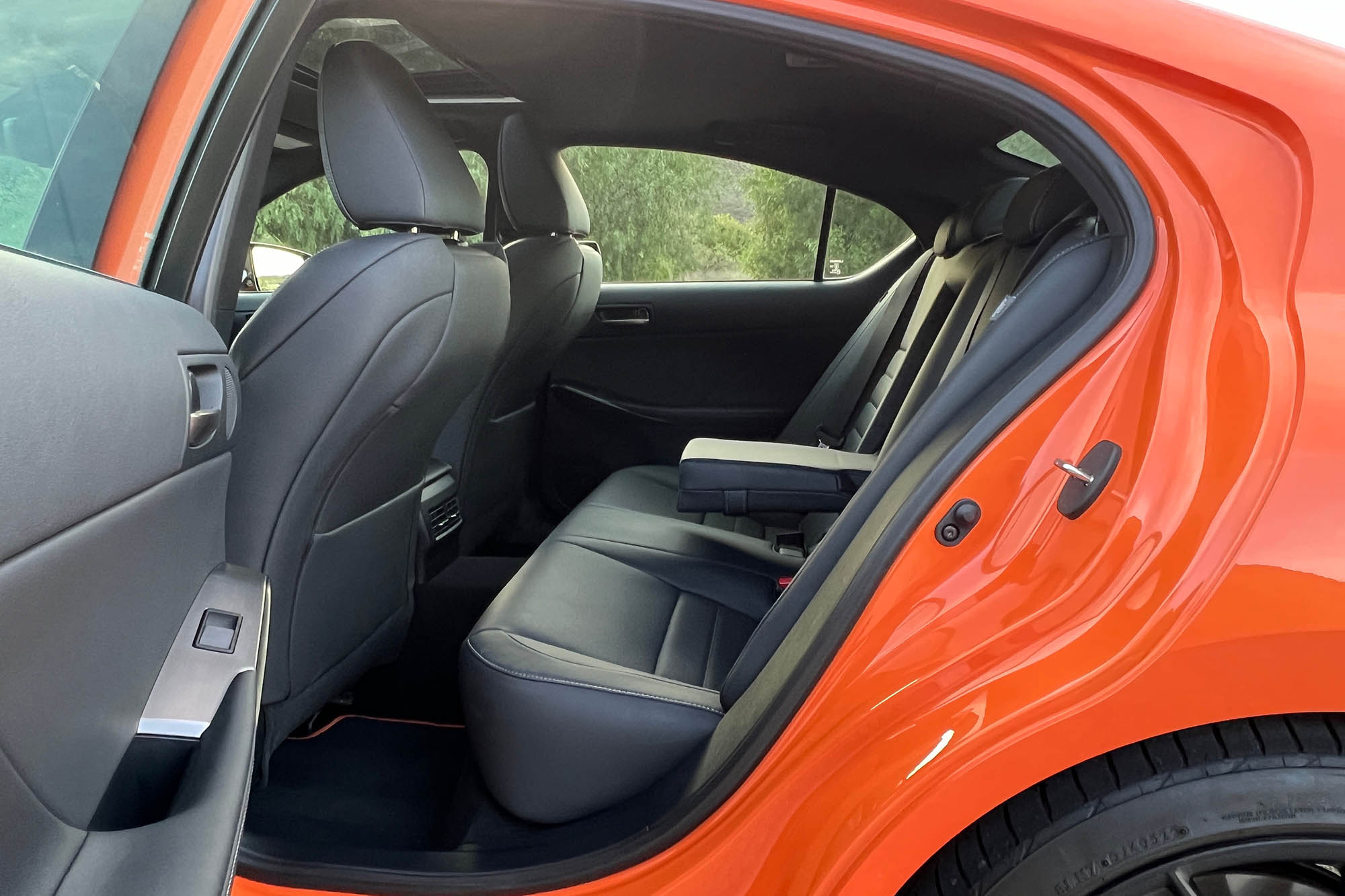 Christian Wardlaw
Christian Wardlaw
Four-Passenger Comfort, Once You're Settled
The Lexus IS is a small, low-slung sports sedan, so getting in and out is a hassle unless you're young and limber. That's especially true of the back seat, where small doors and a low roofline force you to fold yourself like origami to enter and exit.
After you settle in, you'll likely find the snug 10-way power-adjustable driver's seat and eight-way power front passenger's seat comfortable. They're wrapped in perforated NuLuxe, an artificial leather you'd be hard pressed to tell isn't real. In the IS 500, they're also heated and ventilated, and the power tilt-and-telescopic steering wheel has a heated rim. With Premium trim, you get an unnecessary power rear window shade.
Unexpectedly, the IS 500's back seat is just roomy enough for two adults. You won't be able to stretch out, and the headroom is tight, but the cushion is supportive, and Lexus provides rear air-conditioning vents. What's missing? Smartphone charging ports.
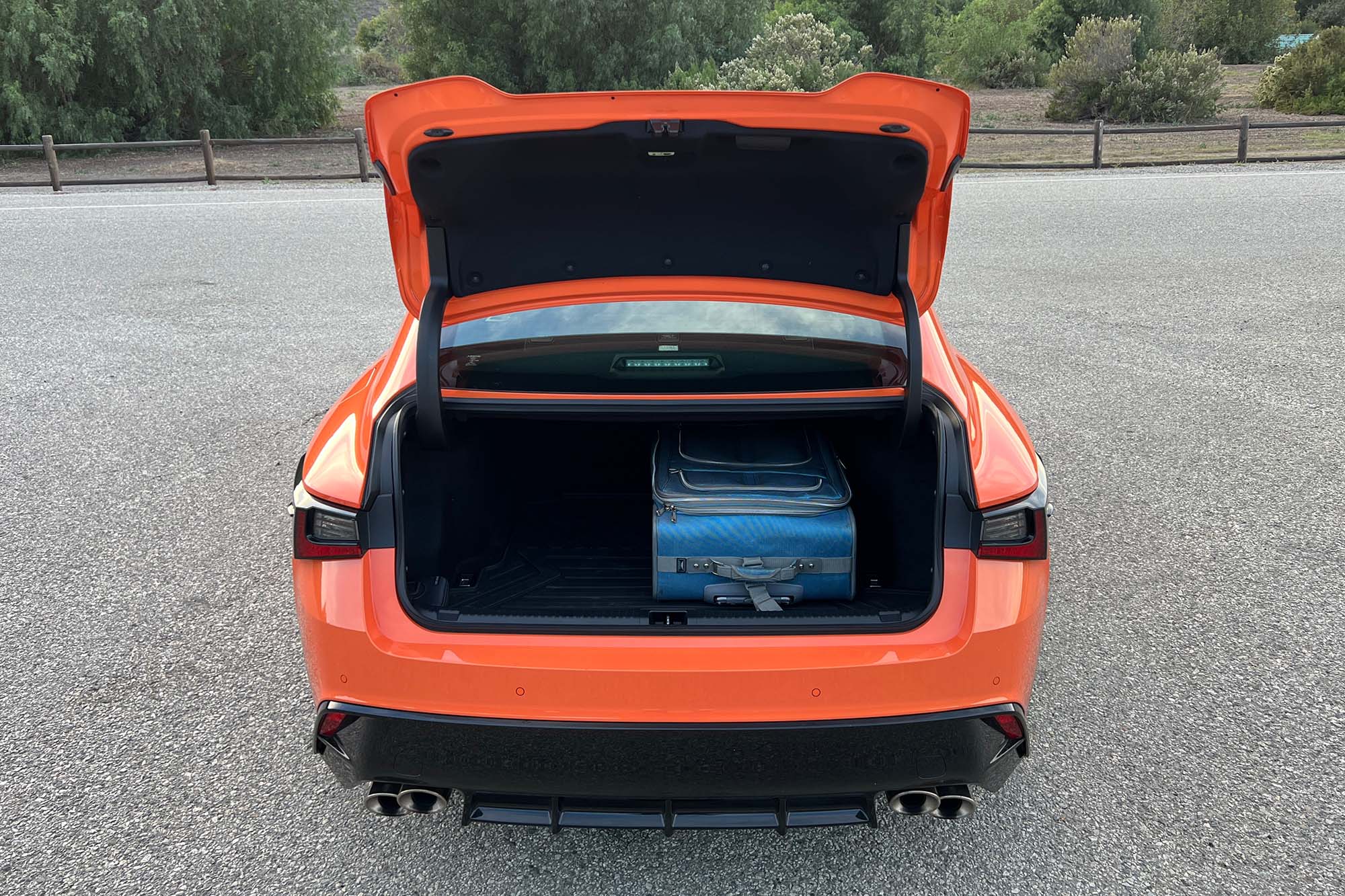 Christian Wardlaw
Christian Wardlaw
The Lexus IS Lacks Storage and Cargo Space
If you bring small items into your car, from house keys and breath mints to a smartphone and water bottle, the Lexus IS offers few places to stash things. The automaker could partly resolve the problem by rearranging the controls on the center console and ridding the car of the touchpad controller for the infotainment system. However, that's unlikely to happen before an IS redesign — if one is in the car's future.
The trunk is small, too, measuring just 10.8 cubic-feet. You can load a couple of full-size suitcases and a few smaller items, and that's about it. But you can fold the 60/40-split folding back seat to expand cargo space.
 Christian Wardlaw
Christian Wardlaw
2023 Lexus IS Infotainment System Is Falling Behind
Lexus does not equip the IS with its latest infotainment technology. Instead of the newest Lexus Interface system, you'll find the old Lexus Multimedia tech. But since Lexus swapped in a touchscreen, the least appealing thing about it is the requirement to connect to Apple CarPlay and Android Auto via USB cable. It's not a wireless system. Smartphone charging isn't wireless, either.
An 8.0-inch touchscreen is standard in the base IS 500, while the IS 500 Premium gets a 10.3-inch touchscreen display. Both include Apple CarPlay and Android Auto connectivity, SiriusXM satellite radio, a Wi-Fi hot spot, connected services providing remote access via app, safety-related features, and more. With Premium trim, you also get a navigation system, an improved voice recognition system, and a 17-speaker Mark Levinson sound system.
I found the test car's voice recognition system to be effective, the touchscreen easy to reach and navigate, and the separate stereo volume and radio tuning knobs indispensable. I found the Mark Levinson audio system sounds better with some forms of music than others.
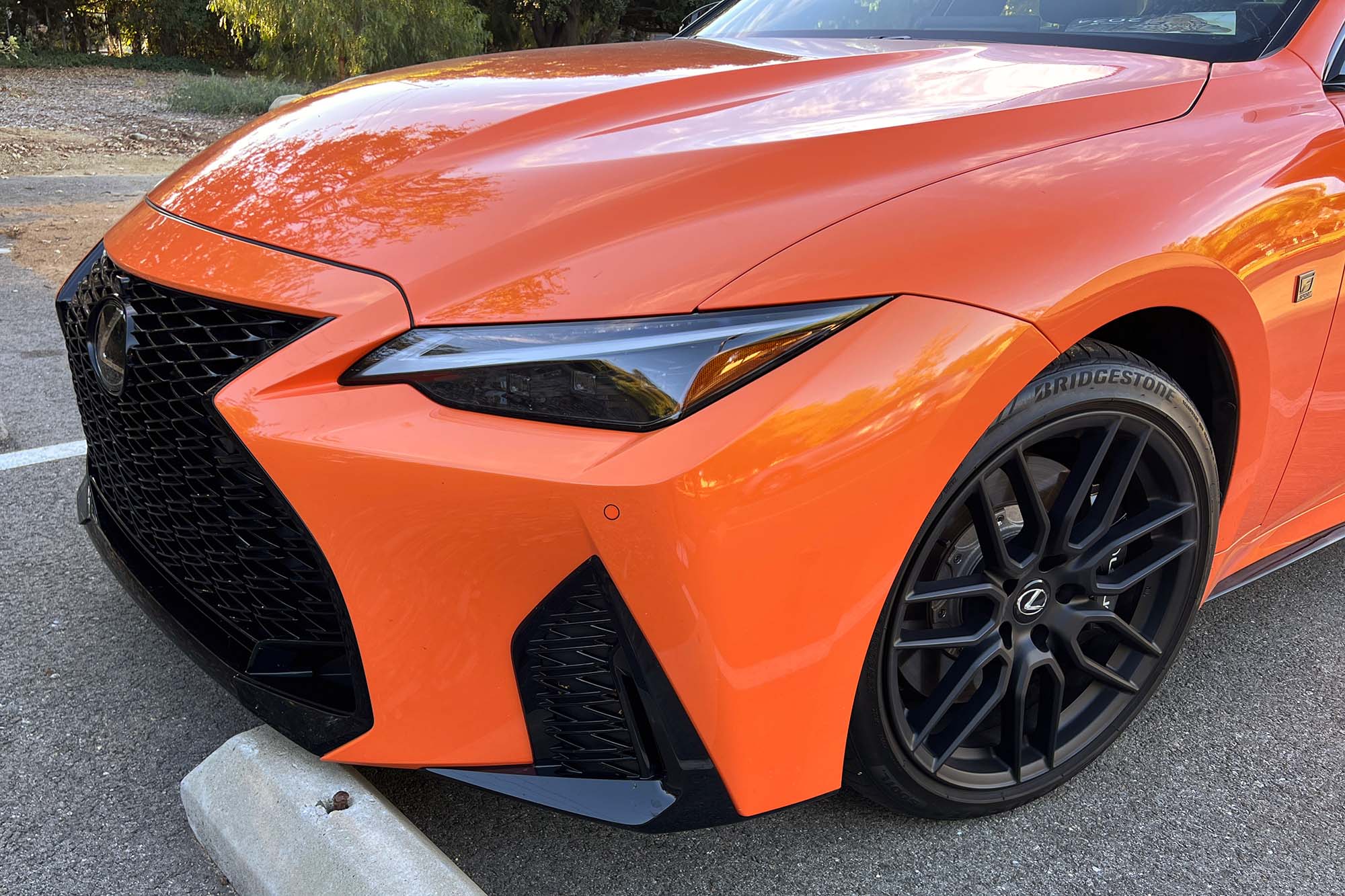 Christian Wardlaw
Christian Wardlaw
A Low-Hanging Air Dam Means Drivers Will Need to Mind the Gap
Lexus will tell you the IS 500's digital instrumentation, with its sliding tachometer and speedometer, is similar to what the automaker offered in its limited-production LFA supercar. That might be true, and I like how it changes its appearance based on the chosen driving mode, but I think the small display and lack of graphic interest pales in comparison with some rivals.
The parking-assist system with automatic braking and the surround-view camera on the Premium trim are helpful, but I think Lexus could improve the car's curb detection and make the front camera activation button more accessible. I nearly crunched the car's low-hanging front air dam on numerous occasions.
 Christian Wardlaw
Christian Wardlaw
The Lexus Safety System+ 2.5 Works Best on Straight Roads
As with the infotainment system, the IS 500's Lexus Safety System+ 2.5 (LSS+ 2.5) is an older but effective technology. It includes helpful features such as forward-collision warning with pedestrian detection, automated emergency braking, lane-departure warning, and lane-keeping assist. Adaptive cruise control, road-sign assist, and automatic high-beam headlights are included as well.
Additionally, the IS 500 comes with 10 airbags, blind-spot monitoring, rear cross-traffic alert with automatic braking, and Safety Connect. Safety Connect is one of the connected service packages, and it adds automatic collision notification and SOS emergency calling to the IS 500.
You activate the IS 500's adaptive cruise control using a small steering column stalk on the lower right side. The design isn't ideal, but has served as a Toyota/Lexus staple since the late 1990s. Therefore, many people are familiar with it.
On freeways, the adaptive cruise control and lane-centering system performed well. The tech brakes smoothly when other motorists cut into the gap ahead and accelerates quickly when you signal to pass slower vehicles.
On straight rural two-lane roads, LSS+ 2.5 resisted the long tree shadows cast on the pavement by fall sunlight and remained accurate in spots where lane lines were fading or obscured by dirt.
The tech proved less impressive on the winding Pacific Coast Highway. The lane centering seems less sure of itself, and the IS 500 would brake when entering bends in the road as if LSS+ 2.5 isn't calibrated to this model's enhanced handling capabilities. On more than one occasion, the car would brake too hard and suddenly for a gentle bend in the road, then accelerate down the next straight section into another gentle bend, and then brake too hard and suddenly again. That behavior was irritating.
In addition, on one section of freshly paved highway blacktop with new lane markings, the lane widened, and the Lexus gave me a false lane-departure warning.
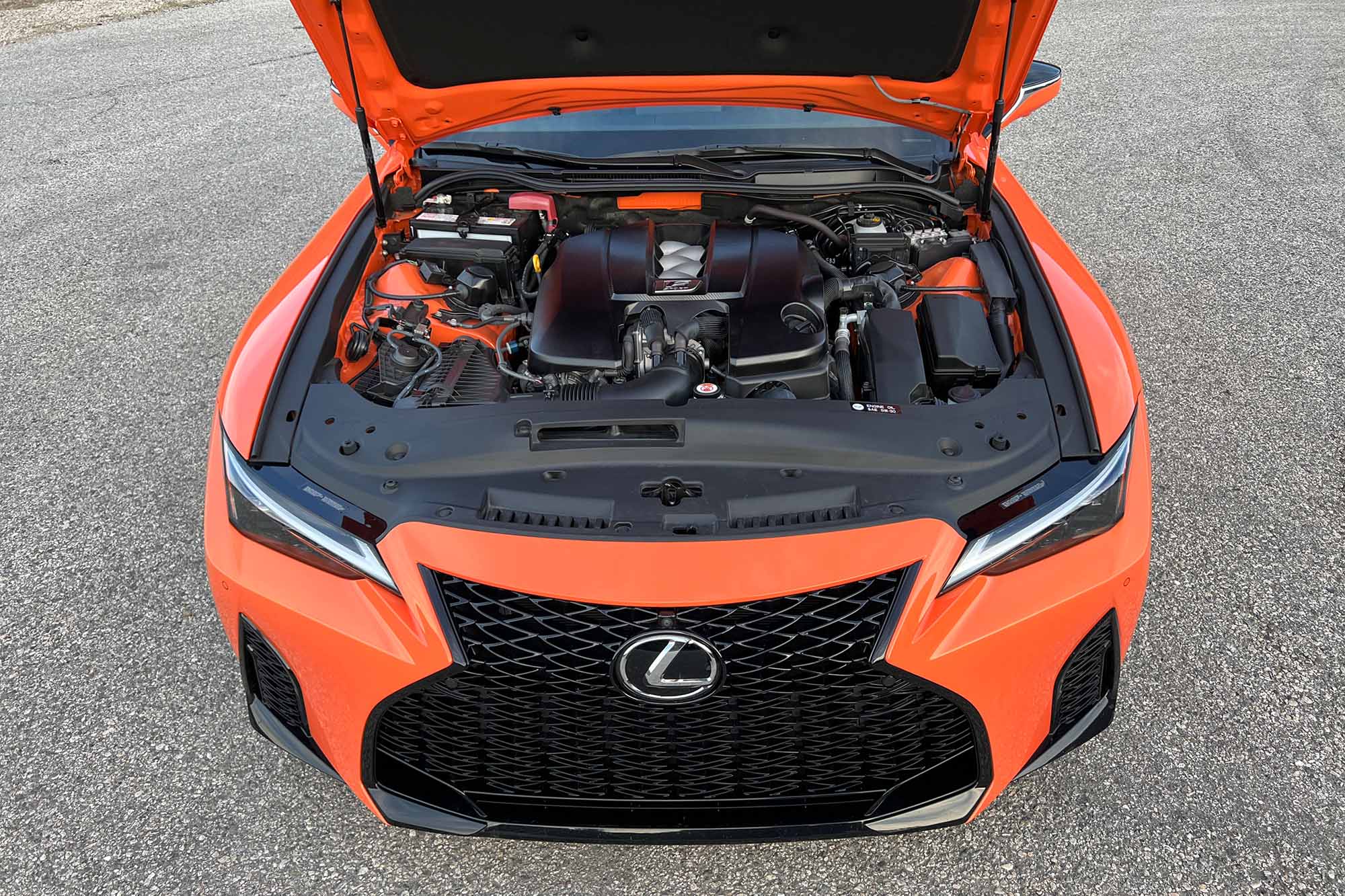 Christian Wardlaw
Christian Wardlaw
High-Revving V8 a Departure From Norms
Lexus equips the IS 500 with a 5.0-liter V8, making 472 horsepower at 7,100 rpm and 395 pound-feet of torque at 4,800 rpm. Those are lofty power peaks by modern standards, reflecting the V8's status as a normally aspirated rather than turbocharged or supercharged engine. In other words, to access that power, you must rev the engine.
An eight-speed automatic transmission with paddle shifters is standard and powers the rear wheels via a limited-slip differential. Drivers choose between Eco, Normal, Sport S, Sport S+, and Custom driving modes, each with a distinct impact on how the car behaves.
In addition, Lexus fortifies the IS 500 with an adaptive suspension with Yamaha rear performance dampers and two-piece front and rear aluminum brake rotors, measuring 14.7 inches in front and 12.0 inches in rear.
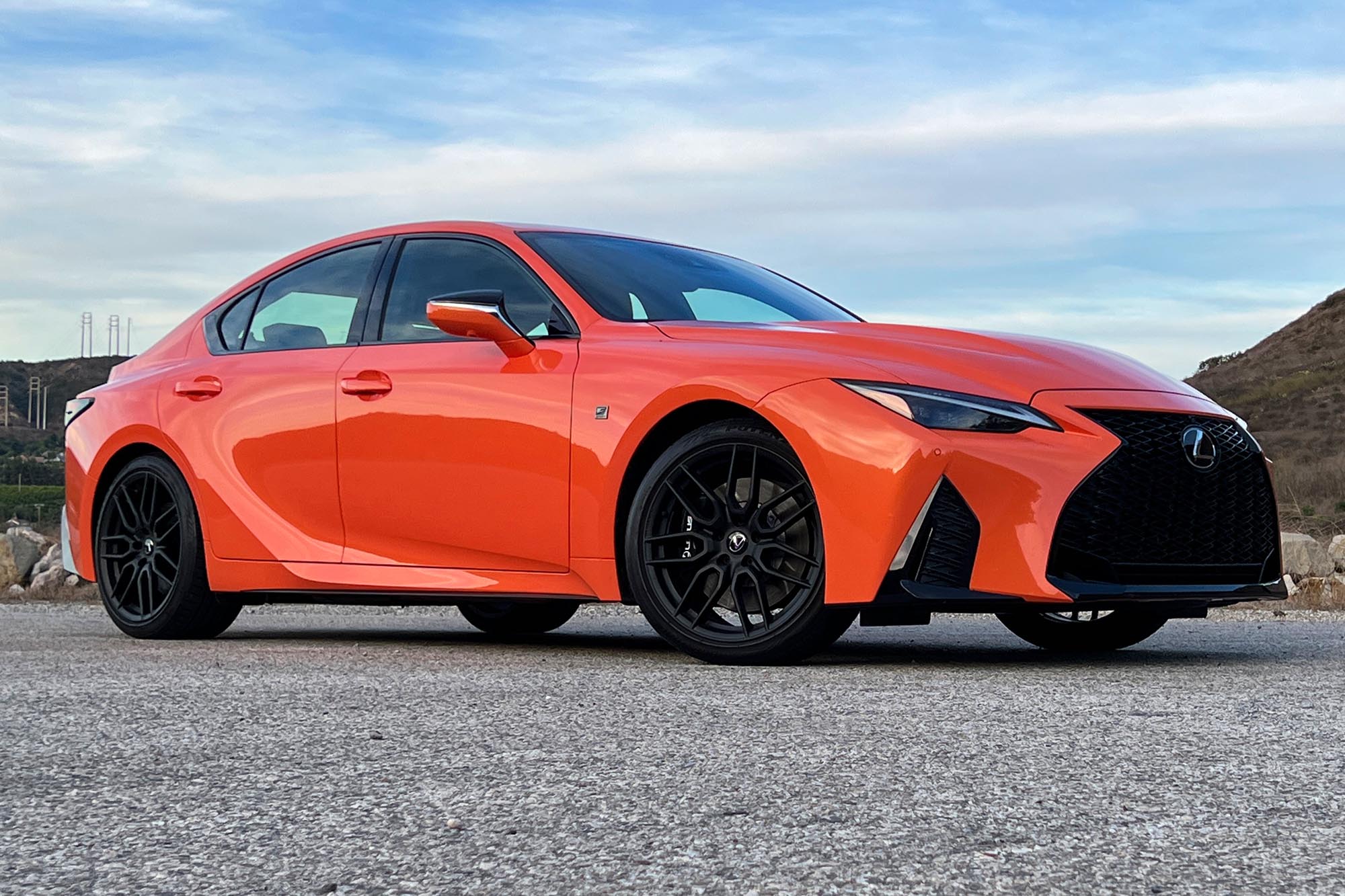 Christian Wardlaw
Christian Wardlaw
Swift, Soft, and Sometimes Sloppy
Push the IS 500's engine-start button, and the V8 rumbles to life. It has a distinctive, almost muted note, loud and menacing enough to convey the car's intent without broadcasting it far and wide.
Acceleration is swift, but not in Eco or Normal modes. In these settings, there is a delay in input response, which can prove frustratingly long. Furthermore, it takes time for the engine to dig into its peak power and torque, so it lacks the kind of thrust you sense in a turbocharged or supercharged vehicle.
Sport S and Sport S+ alter this characteristic for the better, and that's how you can try to match the claimed 4.4-second acceleration run to 60 mph. But that takes a toll on the IS 500's already dismal fuel economy. The EPA says you can expect 17/25/20 mpg in city/highway/combined driving. The test car averaged 18.5 mpg on the evaluation loop.
I used Normal mode in the city and on the highway, switching to Sport S and Sport S+ for mountain driving. These modes alter the appearance of the digital instrumentation, and in Sport S+, using the paddle shifters, you get a visual upshift indicator visible in your peripheral vision. This is critical because if you want to drive the IS 500 with enthusiasm, you'll want to shift the transmission yourself.
 Christian Wardlaw
Christian Wardlaw
Left to its own devices, I found the eight-speed automatic to be a mess. It holds revs too high for too long and never seems to be in sync with the driver. The last car I drove with a similar problem was the Cadillac CT5-V, and like that Caddy, the IS 500 is better when you control the shift points.
In Sport S and Sport S+ modes, the IS 500's exhaust system emits appropriate vocalizations, tamed in the Lexus way. Likewise, the IS 500 feels slightly softer than preferred while threading down Mulholland Highway, displaying too much compliance, though always feeling completely in control.
As a daily driver, the IS 500 is agreeably docile. At highway speeds, however, road noise intrudes on the cabin when traveling on anything but perfect pavement. You must also be aware of that front air dam when parking because the bulging hood makes it harder to gauge where the nose goes.
 Christian Wardlaw
Christian Wardlaw
Celebrate One of the Last V8s
There was a time when conventional wisdom dictated a V8 engine for performance cars and flagship luxury sedans. Lexus crafted its excellent 5.0-liter V8 to serve this purpose. But times are changing and inefficient V8s are on the verge of extinction, so if you want a car like the IS 500, get one while you still can.
As for the Lexus IS lineup, this compact sports sedan remains the closest thing to a Japan-bred BMW 3 Series you can buy.
Written by humans.
Edited by humans.
 Christian Wardlaw
Christian WardlawChris says his first word was "car." For as long as he can remember, he's been obsessed with them. The design. The engineering. The performance. And the purpose. He is a car enthusiast who loves to drive, but is most passionate about the cars, trucks, and SUVs that people actually buy. He began his career as the editor-in-chief of Edmunds.com in the 1990s, and for more than 30 years has created automotive content for CarGurus, J.D. Power, Kelley Blue Book, the New York Daily News, and others. Chris owns Speedy Daddy Media, has been contributing to Capital One Auto Navigator since 2019, and lives in California with his wife, kids, dog, and 2004 Mazdaspeed Miata.
Related articles
View more related articles